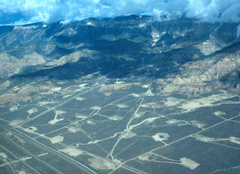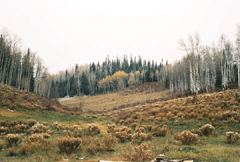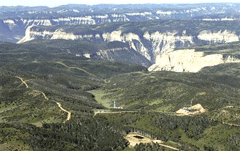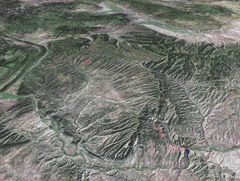Colorado Plateau Drilling Plan
Air Date: Week of June 15, 2007

Gas development on public and private lands is already underway at the base of the Roan Cliffs. The BLM's decision would open up the undeveloped land on the plateau for additional drilling. (Courtesy Colorado Environmental Coalition, 2003)
A stretch of Colorado high plateau, prized by recreationists, may soon be open to gas drilling. The gas industry says Congress intended the oil and gas-rich Roan Plateau to be drilled. But many Colorado residents, and some elected officials, want the federal plan reviewed. Living on Earth’s Ingrid Lobet reports.
Transcript
CURWOOD: It’s Living on Earth. I’m Steve Curwood. In the Rocky Mountains hunting and conservation groups have been fighting hard to protect what they consider sensitive terrain from the natural gas drilling boom with all its roads, pipelines and wellheads. And it looks like they have lost a battle: the federal agency that oversees Colorado’s Roan Plateau says the drill-rigs may now enter. Living On Earth’s Ingrid Lobet reports.
LOBET: North of interstate 70 in western Colorado, steep cliffs rise and then flatten onto the Roan Plateau, and its forests, native trout streams and colored canyons. Marc Smith of the Independent Petroleum Association of Mountain States knows the area by a different name: the Naval Oil Shale Reserves 1 and 3.

Gas development on public and private lands is already underway at the base of the Roan Cliffs. The BLM's decision would open up the undeveloped land on the plateau for additional drilling.
(Courtesy of Colorado Environmental Coalition (2003))
LOBET: Energy companies that lay the pipe, set drill rigs and build roads have pressed to get into this area, because the reserves underneath are so rich.
SMITH: The Naval Oil Shale Reserves 1 and 3 hold enough natural gas to heat four million homes for 20 years. Some nine trillion cubic feet of fuel.
LOBET: Now after years of controversy, the Bureau of Land Management has decided to open up about half the public land on top of the plateau to gas drilling.

Aspen trees and old-growth Douglas Firs make up a lot of the forest land on the plateau.(Courtesy of the Bureau of Land Management)
BASTABLE: I just can’t express the values that are up there and the values that are at stake with this.
LOBET: Clare Bastable has spent weeks camping on the plateau. She’s with the Colorado Mountain Club, one of many hunting, fishing, conservation and recreation groups banded together in the campaign for the Roan Plateau.
BASTABLE: It’s one of the central locations for mule dear and other big game populations and so it’s really a haven for wildlife. It’s just got such an incredible diversity in its landscape from kind of rolling hills, to spruce and fir, and aspen forests to deep canyons that have been likened to Yosemite.
LOBET: Below the plateau there are thousands of new gas wells on both public and private land. In Garfield County alone, were much of the plateau sits, 1700 new wells were approved last year.

The plateau is home to elk, mountain lion, golden eagles and the Columbian Sharp-tailed grouse. (Photo:Ingrid Lobet (2005))
BASTABLE: Not every landscape, every last landscape, needs to be drilled and the Roan falls under one of these landscapes that we feel needs to be protected.
LOBET: Some maintain that even under the new plan, it will be. BLM has included what all agree are some new safeguards. Energy companies will only be allowed to tear up 350 acres of pipeline path or drilling area at a time. Then they’ll have to replant that scraped earth with native plants before moving on to the next ridge top.
Rural Garfield County stands to gain some 57 million dollars a year under the BLM’s lease plan. Nevertheless, public sentiment in this part of the country has been shifting toward more environmental protection as gas wells proliferate. The new governor of Colorado, Bill Ritter, was not happy when the BLM issued the plan and refused to give him more time to weigh in on something that had been approved by the prior Republican governor. Spokesman Evan Dreyer.

Computer generated, panoramic aerial view of the Roan Plateau. (Photo: Dr. William Bowen. California Geographical Survey)
DREYER: Those two actions deny what is a new administration ample time to review what is a very significant public policy matter that concerns the entire state of Colorado.
LOBET: Now Governor Ritter is backing a more adversarial effort by two Colorado congressmen and a senator to slow down the project by blocking money for it in Congress. Again, Evan Dreyer.
DREYER: Well, the BLM says that its decisions are based on directives from Congress, so we are seeking through legislation, Congressional legislation what we had asked for administratively—additional time.
LOBET: If that effort fails and no judge issues a stay, bidding would soon begin for the right to drill in this sought-after corner of the Rockies.
For Living on Earth, I’m Ingrid Lobet.
[MUSIC: Shearwater “I Can’t Wait” from “Waterloo Records 25th Anniversary’ (Waterloo Records – 2007)]
Links
Independent Petroleum Association of Mountain States site
Living on Earth wants to hear from you!
Living on Earth
62 Calef Highway, Suite 212
Lee, NH 03861
Telephone: 617-287-4121
E-mail: comments@loe.org
Newsletter [Click here]
Donate to Living on Earth!
Living on Earth is an independent media program and relies entirely on contributions from listeners and institutions supporting public service. Please donate now to preserve an independent environmental voice.
NewsletterLiving on Earth offers a weekly delivery of the show's rundown to your mailbox. Sign up for our newsletter today!
 Sailors For The Sea: Be the change you want to sea.
Sailors For The Sea: Be the change you want to sea.
 The Grantham Foundation for the Protection of the Environment: Committed to protecting and improving the health of the global environment.
The Grantham Foundation for the Protection of the Environment: Committed to protecting and improving the health of the global environment.
 Contribute to Living on Earth and receive, as our gift to you, an archival print of one of Mark Seth Lender's extraordinary wildlife photographs. Follow the link to see Mark's current collection of photographs.
Contribute to Living on Earth and receive, as our gift to you, an archival print of one of Mark Seth Lender's extraordinary wildlife photographs. Follow the link to see Mark's current collection of photographs.
 Buy a signed copy of Mark Seth Lender's book Smeagull the Seagull & support Living on Earth
Buy a signed copy of Mark Seth Lender's book Smeagull the Seagull & support Living on Earth

